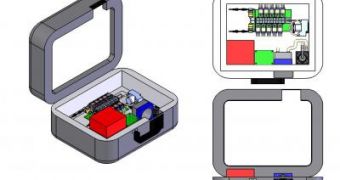In the current war against terrorism, a new weapon has emerged.
Employing lasers and tuning forks, a team at the Pacific Northwest National Laboratory has made a chemical sensing technique that even overpasses current defense and homeland security chemical detection requirements.
The Quartz Laser Photo-Acoustic Sensing (QPAS) has been able to detect a gaseous nerve agent surrogate, diisopropyl methyl phosphonate (DIMP) (a chemical similar to sarin).
QPAS spotted DIMP at the sub-part-per-billion level in less than one minute, a level equal to letting one drop of liquid DIMP evaporate into a volume of air compassing over two Olympic-size swimming pools.
"QPAS is an extremely sensitive and selective chemical detection technique that can be miniaturized and yet is still practical to operate in field environments," said Michael Wojcik, a research scientist at PNNL.
"The laser, tuning fork and other technology needed for QPAS are so simple, and yet robust, that further development is a low-risk investment, and we're eager to take it to the next level."
QPAS is based on Laser Photo-Acoustic Sensing (LPAS) and infrared Quantum Cascade Lasers (QCLs).
LPAS is an extremely sensitive type of optical absorption spectroscopy which employs a pulsed laser beam to make a brief absorption in a sample gas, which responds with a very small acoustic signal registered by a miniature quartz tuning fork.
Multiple QCLs were paired with the tuning forks, permitting the analysis at the same time of a sole sample in many infrared wavelengths.
Almost each molecule has specific optical properties at infrared wavelengths between 3 - 12 micrometers, and QCLs investigate any wavelength in this area.
"Because of this access and the fact that QPAS is almost immune to acoustic interference, we have potential for extraordinary chemical sensitivity and selectivity," said Wojcik.
QPAS is a huge step forward compared to previous LPAS instruments, which were large, often over a meter (3 ft) in length and less effective, cumbersome, power-hungry and vulnerable to interference from external sound and vibration.
In the QPAS, several QCLs can match on a 3 x 3 millimeter chip.
The tuning forks are similar to those employed in wristwatches, being only 4 mm long, 2 mm wide and 0.3 mm thick.
The prototype QPAS sensor, including 10 pairs of QCLs and tuning forks, enters into a briefcase that is 12 inches (30 cm) long, 12 inches wide and 6 inches (15 cm) high with a weight of less than 6 kg and is battery powered.
Moreover, the instrument can function unattended for long periods of time.

 14 DAY TRIAL //
14 DAY TRIAL //